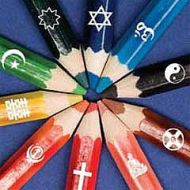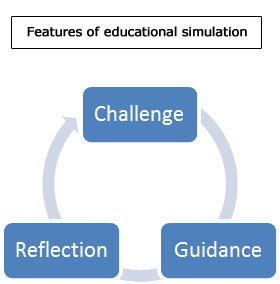
-
 History of Religions
History of the 3 Monotheistic religions (Judaism, Christianity and Islam) and of the main different Christianity confessions (Roman Catholicism, Eastern Catholicism and Eastern Orthodoxy, Anglicanism and Protestantism)
History of Religions
History of the 3 Monotheistic religions (Judaism, Christianity and Islam) and of the main different Christianity confessions (Roman Catholicism, Eastern Catholicism and Eastern Orthodoxy, Anglicanism and Protestantism)
-
 Pedagogical Approaches
New pedagogical approaches to teach history of religion
Pedagogical Approaches
New pedagogical approaches to teach history of religion
-
 Role of Religions in Civilization
How to didactically promote among students of different confessions, the capacity of a critical analysis and understanding of the role played by religions in the history of mankind
Role of Religions in Civilization
How to didactically promote among students of different confessions, the capacity of a critical analysis and understanding of the role played by religions in the history of mankind
-
 Interreligious Students’ Competences
Set of teaching contents, to be used by teachers to highlight and valorize the universal values of tolerance and universalisms that all Monotheistic religions and religious texts contain to promote and sustain mutual understanding among students
Interreligious Students’ Competences
Set of teaching contents, to be used by teachers to highlight and valorize the universal values of tolerance and universalisms that all Monotheistic religions and religious texts contain to promote and sustain mutual understanding among students
-
 Managing Multi-Religious Classes
Teaching Sources to help teachers dealing with multicultural and multi-religious classes
Managing Multi-Religious Classes
Teaching Sources to help teachers dealing with multicultural and multi-religious classes
-
 Introduction
A comparative review of the liturgical celebrations, ceremonies and dietary rules existing in the different religions.
Introduction
A comparative review of the liturgical celebrations, ceremonies and dietary rules existing in the different religions.
-
 Celebrations
Description and comparative analysis of the celebrations of different religions and confessions
Celebrations
Description and comparative analysis of the celebrations of different religions and confessions
-
 Ceremonies
Description and comparative analysis of the ceremonies of different religions and confessions
Ceremonies
Description and comparative analysis of the ceremonies of different religions and confessions
-
 Dietary Rules
Description and comparative analysis of the dietary rules of different religions and confessions
Dietary Rules
Description and comparative analysis of the dietary rules of different religions and confessions
Events
The Pathway through Religions project has been promoted trough conferences and articles.
Partnership
-
 Contractual Partners
From this section it is possible to access to a description of each contractual partner of the Pathway through Religions project.
Contractual Partners
From this section it is possible to access to a description of each contractual partner of the Pathway through Religions project.
-
 Schools
From this section it is possible to access to the information about the schools involved in the Pathway through Religions Project in the European countries involved.
Schools
From this section it is possible to access to the information about the schools involved in the Pathway through Religions Project in the European countries involved.
-
 Associated Partners
As a result of the exploitation activity a number of associated partners officially joined the project in order to contribute to the improvement of the project impact on their target groups and to ensure the project sustainability by continuing using the project deliverables in the next years.
Associated Partners
As a result of the exploitation activity a number of associated partners officially joined the project in order to contribute to the improvement of the project impact on their target groups and to ensure the project sustainability by continuing using the project deliverables in the next years.
This section of the Pathway through Religions portal provides administrative information for the project contractual partners and for the European Commission and it is password protected.
Managing Multi-Religious Classes
Homepage > Teachers’ Guide > Managing Multi-Religious Classes

Teaching Sources to help teachers dealing with multicultural and multi-religious classes
Managing Multicultural and Multi-Religious Classes
4. Use of Distancing and Simulation
Exploring cultural and religious differences in the classroom may feel threatening for many students. They could perceive it as an intrusion in their private life. If pressed to confess their personal beliefs and practice, they can easily become defensive. Students from minority groups may feel that they are singled out or that their loyalty is put to the test.
A variety of distancing techniques can be used to engage pupils in intercultural dialogue without undue embarrassment, anxiety or fear. Some examples include:
Simulations are a potent educational tool that makes use of distancing. Students role-play real life scenarios that deal with diversity, conflict and moral dilemmas. Being in a role, identifying with a character and responding to the emergent situation in the here-and-now allows pupils to explore different solutions in fun and creative way. Pretending to be somebody else gives a new perspective that can be liberating.
 Students should be helped to really step into the shoes of their character and impersonate him/her as vividly as possible. The teacher encourages risk-taking and guarantees that no harm will be done. She can pause the simulation at critical moments. This allows more time for students to assess the situation and decide how to act. After the enactment, structured de-roling and reflection should be initiated.
Students should be helped to really step into the shoes of their character and impersonate him/her as vividly as possible. The teacher encourages risk-taking and guarantees that no harm will be done. She can pause the simulation at critical moments. This allows more time for students to assess the situation and decide how to act. After the enactment, structured de-roling and reflection should be initiated.
A major advantage of educational simulations is that they provide "hands-on" training. Students become active participants and learn by doing, gaining practical knowledge and personal experience along the way. Simulations call for students to be flexible and to adapt to change. They enable them to transfer knowledge and skills from one environment to another which results in improved self-efficacy.
A variety of distancing techniques can be used to engage pupils in intercultural dialogue without undue embarrassment, anxiety or fear. Some examples include:
- using real people as exemplary studies - religious leaders, cultural heroes, celebrities
- using fictional characters from movies and literature who represent various religious beliefs and practices
- using stories and artefacts to depict various cultures and spiritual traditions
Simulations are a potent educational tool that makes use of distancing. Students role-play real life scenarios that deal with diversity, conflict and moral dilemmas. Being in a role, identifying with a character and responding to the emergent situation in the here-and-now allows pupils to explore different solutions in fun and creative way. Pretending to be somebody else gives a new perspective that can be liberating.
 Students should be helped to really step into the shoes of their character and impersonate him/her as vividly as possible. The teacher encourages risk-taking and guarantees that no harm will be done. She can pause the simulation at critical moments. This allows more time for students to assess the situation and decide how to act. After the enactment, structured de-roling and reflection should be initiated.
Students should be helped to really step into the shoes of their character and impersonate him/her as vividly as possible. The teacher encourages risk-taking and guarantees that no harm will be done. She can pause the simulation at critical moments. This allows more time for students to assess the situation and decide how to act. After the enactment, structured de-roling and reflection should be initiated.
A major advantage of educational simulations is that they provide "hands-on" training. Students become active participants and learn by doing, gaining practical knowledge and personal experience along the way. Simulations call for students to be flexible and to adapt to change. They enable them to transfer knowledge and skills from one environment to another which results in improved self-efficacy.
Online Resources
- Educational SimulationsA short overview of educational simulations types and their benefits.
- Using Distancing TechniquesA collection of ten distancing techniques to be used in the classroom.
- Simulations Can Change the Course of History . . . ClassesThis article gives some tips for transforming the history classroom into a simulation-driven, game-based learning environment. It makes a case for increasing student engagement through role-plays and self-directed research.
Practical Activity
- The Heated DebateThis is a simulation of a heated debate between secular and religious leaders. Students engage in role-play dealing with issues such as migration, gender equality and gay rights.


